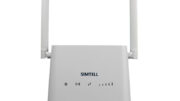Optical fiber is one of those things that we sort of take for granted. It wasn’t always the case. They’ve been around since the 1950s, but it wasn’t until the 1980s that they started to be used for communications. In the 21st century, they’ve become the default way of getting information from place to place, supplanting big copper wires. In order to understand why fiber is so magical, you have to understand a little bit of why it does what it does, and how that differs from the way that copper wires work.
Electrical transmission
In the 19th century, we began to get an understanding of electricity. Electricity is a natural phenomenon that has always existed, but it’s only been in the last 150 years or so that humans have been able to use it for their needs. The first uses of electricity, of course, was to power things. Things like light bulbs, for example. And, perhaps more importantly to this article, it was discovered very early on that you could power something pretty far away if you ran a copper wire to it.
This simple discovery, and the principle of conductivity which makes it possible, meant that you could press a telegraph key in one city and something in a completely different city could make a “click” sound. That in itself was revolutionary. But, it was only the beginning. By the late 19th century, we began to understand that it wasn’t just current that you could send along a wire. You could send signal.
A signal is a representation of a particular state of the electromagnetic spectrum, sent over a wire. (What?) I know, that sounds pretty hard to understand. But The upshot is this. Before we understood signal, we could only send simple clicks. With an understanding of how signals travel over wire, we could turn sounds into electricity, send that electricity over a wire, and have it turn back into sound on the other side.
For about 100 years, this remained the state of the art. Giant copper cables were constructed which could carry hundreds or even thousands of signals at the same time. Each large copper cable was made up of lots of little copper cables.
That all worked well enough, except that it took a lot of energy and a lot of copper to get signals to travel. By the mid-20th century some people legitimately worried that there wouldn not be enough copper in the world to send all the signals people wanted to send. And that’s where optical transmission comes in.
Digital transmission
Before I really talk about optical transmission, we need to talk about analog vs. digital transmission. Analog transmission was used for all that time over copper wires, and it worked well. It’s hard to really explain what analog transmission is, but here’s something that makes sense to me:
Imagine you have a deck of cards. You can look at a card and see the entire card all at once. You can look at that card, then pick another card, look at it, and keep going. It won’t take you long to go through the whole deck. That’s analog transmission. You see the entire card at once, then you see another whole card at once.
Now let’s pretend you had to put a deck of cards through a very tiny hole, about the size of your pinky nail. (Let’s not talk about why, that’s not the point of the analogy.) You might not know how to do it. Well, that you do is cut each card up into 128 pieces and put each card through that hole, in order. Then you could tape together the whole card on the other side of the hole. Then you’d start on another card. This is digital transmission. We cut our signal up into tiny bits, send them through a wire in order, and put them back together. That way, we can use a tiny wire instead of the big fat one we needed for the analog transmission.
Optical fiber
Confused yet? If so, take a little break.
OK, let’s get started again. Digital transmission is pretty hard for humans, but it’s easy for computers. So when computers started getting more powerful in the 1970s, communications companies wanted to use digital transmission. This would let them use less copper. But, they quickly realized it wasn’t going to solve the problem. You could only send information so fast through copper, and you still needed a heavy copper wire. That’s where fiber optics come in.
An optical fiber is a long strand of plastic or glass that is designed in such a way that very little light leaks out the sides of the strand. Almost all the light goes from one end to the other. Very little light is lost, especially compared to the electricity that’s lost in a similar length of copper. Optical fibers can be very thin, about as thick as a human hair. So a big bundle of them designed to replace a two-foot-wide copper cable can be only about an inch thick.
Yeah, but how does it work?
Right, right. That’s the whole point of the article. I got off track there for a minute.
The irony here is that fiber optics work precisely the same way as telegraph line. With a telegraph line, electricity goes down the line as a series of pulses. Those pulses formed a code, with each pattern of pulses making a letter. The letters were combined into words, the words into whole messages.
The same is true of fiber optics. Bright light sources, usually lasers, turn on and off to form pulses of light. The pulses are a code that forms letters, words, and messages. It works better than telegraph lines for a couple of reasons. First, it’s all run by computer so the pulses can be incredibly fast. Second, the fibers are miles and miles long. Even at that distance they still let light travel down them in a way computers on the other side can decode the information. Third, as I said fiber optics are thin and light. They’re cheaper than copper and they just work better. It’s a win for everyone.
And video? You were going to talk about video
You are so right. Remember a couple paragraphs ago when I was talking about playing cards in a deck? Instead of playing cards, imagine you’re working with frames of video. Each frame is a snapshot of what you see in that moment in time. We combine 60 of these frames every second, show them in order, and you get moving video. Send a second signal with sound, and it all seems realistic.
And it’s done like I described it with playing cards. Each frame is broken down into bits. The bits are sent down in order and recombined on the other side. Computers can do this so quickly that they can assemble a picture made of 2,073,600 bits every 60th of a second.
It’s all due to these incredibly, incredibly fast pulses of light that travel down fiber optics. And it works so fast you can’t even conceive of it.
Before anyone else mentions it…
With modern digital video systems, there’s also compression, which reduces the digital signal so it can be transmitted more efficiently. But that’s a story for another article.
This article is brought to you by Solid Signal. Shop at Solid Signal for everything you need to live your best digital life, even fiber optics. If you have questions, call us at 888-233-7563 or fill out the form below.





